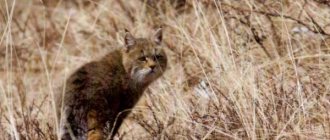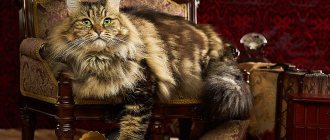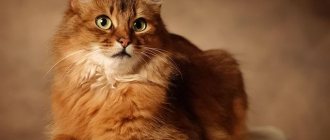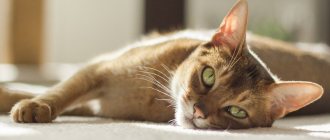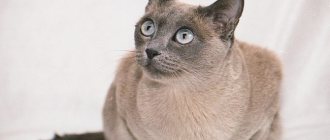The Chinese Li Hua is one of the oldest breeds. It arose as a result of the domestication of wild mountain cats. Often these animals are also called Dragon Li or Li Mao. Despite the fact that even in their homeland they are quite rare, they are very loved and revered there. In other countries, only connoisseurs have heard of them, since this breed is quite small in number.
Appearance and breed characteristics
The Gobi gray cat lives in China, which determines the second name of the representatives of the breed. Natural habitat is mountainous areas, steppes and forests.
Poaching, expanding agricultural activity leading to food shortages, and large dangerous predators are the main reasons that led to a multiple decline in the population. Today, this unique breed is on the verge of extinction, and therefore is included in the Red Book.
The Gobi gray cat is distinguished by its muscularity and large build. The average height of adult individuals is about 100 cm, the weight category varies from 4 to 9 kg.
The Chinese cat has a large head , large ears with specific tufts at the ends, and a powerful and thick fluffy tail . The animals have very beautiful, long thick hair with a pronounced undercoat. It was the luxurious, shiny fur that was the reason for the hunting, which led to a sharp reduction in the number of Chinese cats.
color changes depending on the time of year. So, in the summer months the fur has a grayish-yellow tint, and in winter it becomes darker with a predominance of brown tones. Against this background, the large and expressive emerald-colored eyes .
The tip of the tail is black. The coat of the Gobi gray cat has spots and stripes that do not stand out too much. Thanks to this color, the Chinese cat has the ability to easily camouflage itself in natural conditions.
The thick undercoat protects the animal from wind and cold, and its muscular, strong paws help it quickly run away from enemies and break holes in search of food. Like many other predators, the Chinese cat has excellent hearing and excellent sharp vision.
Character and behavior in the wild
The Gobi gray cat is a loner, unsociable and difficult to make contact, therefore the behavior of purebred representatives is considered poorly studied. Like most predators, Chinese cats prefer to lead a nocturnal lifestyle, sleeping and accumulating strength for future hunting in the daytime.
These animals live separately, uniting in pairs only for the purpose of reproducing offspring for a short period of time. Chinese cats live in burrows, which they create for themselves. There they are reliably protected from enemies and have the opportunity of safe privacy.
Gray cats are very smart, dexterous, graceful and patient. These animals can observe and track their prey for a long time before attacking it. Brilliant hunters, excellent tree climbers.
Origin story
The cat breed with the colorful name Chinese Li Hua Mao is better known in the West as Dragon Li. The Chinese themselves do not use this name, but call animals in the national spirit, it looks like 狸花猫. It is difficult to adequately translate the hieroglyphs into Russian; literally they mean: “fox flower cat.”
Residents of the Middle Kingdom are sure that their Li Mao descended from a wild Chinese cat. This statement raises doubts among felinologists; all that can be said for certain is that these animals appeared in China a very long time ago. The first official mention of similar cats dates back to the Tang Dynasty in the first century AD. e. Since mid-level officials were allowed to keep cats at that time, the animals quickly spread throughout the empire.
In 2004, the breed was first presented at an exhibition in Beijing. At the same time, several representatives were taken to the United States. After 2 years, a breed standard was developed and adopted, and in 2010, Li Hua Mao was registered by the CFA breeding association.
Video review of the Dragon Li (Chinese Li Hua Mao) cat breed:
How does reproduction occur?
The breeding season lasts from January to March inclusive. After the birth of offspring - from 2 to 4 babies, the temporarily created pairs break up. Kittens live with their mother until they reach 7-8 months of age. At first, the Chinese cat feeds the babies with milk and takes care of their safety.
Even during pregnancy, the female Gobi gray cat creates a cozy and warm burrow with numerous passages and labyrinths, inaccessible to other predators. When the kittens grow up, he begins to take them hunting with him, teaching them the skills necessary to survive in the wild.
Having reached a certain age, kittens leave the den and begin an independent life. It is interesting that at first the animals live not far from their mother’s hole. And only after reaching puberty do they completely separate from it, occupying their own separate territory. By the age of one year, the gray Gobi cat is already a fully formed individual, capable of reproduction.
Nutrition, care
The short, plush coat requires special care. Comb
cubs should be bathed once every 7 days and every month. Cats are unpretentious in their diet. The diet should include fermented milk products, cereals, vegetables, and meat. A bowl of clean water should always be there. Additionally, vitamins for cats should be given. Unfortunately, Snoopies are prone to genetic diseases. Problems arise with the respiratory system, lacrimation or obstruction of the lacrimal canal. For timely diagnosis of the disease, it is recommended to periodically visit a veterinarian.
Is it possible to keep in captivity?
As animals officially listed in the Red Book, Chinese cats cannot be kept as pets at home. Representatives of this rare breed live in nature reserves and zoo corners.
It is not difficult to purchase a baby Gobi gray cat on the illegal market for a lot of money. But potential owners must understand that it will be quite difficult for such a wild animal to provide all the necessary conditions, without which it will soon begin to get sick, wither and, as a result, simply die.
Area
Most often, this breed is found in the north-west of China, in the mountains and steppes, as well as in Mongolia. The majority of representatives live in areas of high altitudes. As a rule, these are meadows, clearings with bushes, and forests. It is impossible to meet the Chinese breed in actual deserts. The kittens, whose photos are posted in the article, prefer warm climates. If we talk about mountains, then individuals are found at an altitude of 2-4 thousand meters above sea level. This breed is able to withstand harsh weather conditions, including temperature changes. Strong winds often blow (mostly dry), which are observed all year round. Winters in this area are too cold and summers are too hot.
Features of behavior at home
Chinese cats love solitude and loneliness and try to avoid any contact with both humans and other pets. This character trait, autonomy and independence are preserved even after long-term living at home. With all its might, such an animal will look for a place for solitude, try to create a secluded place for itself, some kind of hole or lair, similar to natural water conditions.
Even if you adopt a small kitten, you will not be able to make it an easy-going and affectionate pet.
Moreover, representatives of the breed cannot tolerate anesthesia and surgery, and accordingly, castration or sterilization, which changes the character of cats, becomes impossible.
When living in artificial conditions, the Gobi gray cat retains its hunting instincts and continues to be nocturnal, being active only at dusk.
Difficulties may also arise during the breeding season. The fact is that finding a suitable mate for a rare animal in artificial conditions is difficult and problematic. During the mating period, the female may become nervous, irritable and even show aggression.
During the breeding season, males can perceive even their owner as a competitor. For this reason, it is extremely important to observe changes in the animal’s psycho-emotional state and behavior, not to bother him and try to limit his contacts with babies.
Chinese cats are loners by nature, and therefore will not tolerate the proximity of other pets. As for small living creatures - birds and rodents, they are completely incompatible with a cat, which retains its hunting instincts throughout its life.
It should also be noted that throughout its life the animal retains a tendency to mark its territory, so toilet training is an almost impossible task.
Serengeti
The history of the appearance of this breed begins among the endless plains and prairies of the American Serengeti National Reserve, where at sunset their ancestors of the Serval breed go hunting.
The administrator of a local wildlife sanctuary fell in love with servals the first time she saw them. And from that moment on, she decided to produce a similar spotted breed of cat, but only with a more domesticated and docile character. And she succeeded.
Many people are admirers of large animals, so we bring to your attention the ratings of the largest cats and dogs.
Serengeti
The fur of these cats is quite short, but silky. There are many color variations, ranging from traditional leopard-tiger tones, ending with silver-black and even purple. The eyes are mostly emerald and green, less often golden sand and terracotta.
These cats are much larger than all those previously discussed. Their weight can reach 15 kg, and their height varies between 30–40 cm. Their tail is equal to two-thirds of the body length, quite thick and elastic.
These cats have a very developed vocal apparatus, and therefore they can produce a huge number of sounds - from almost inaudible high to deep and deep-laryngeal bass, which can frighten the owner of such a pet for the first time.
Serengeti are agile, subtle and graceful, and therefore there is no end to their energy and activity. If there are other pets in the house, the Serengeti will quickly put them in their place, taking their rightful position in the center of everyone's attention.
When communicating with people, these cats are very gentle and affectionate, completely opposite to their wild counterparts of similar color. Such a cat will always involve its owners in its games and take up a lot of time, requiring affection and plenty of communication. They are quite easy to care for, thanks to the unpretentiousness of the wool. Feed, play and show affection, and your pet doesn’t need more.
Important! The Serengeti are very sociable. They love all kinds of trips and walks, and at the exhibition they behave so sedately and proudly, as if this exhibition is dedicated specifically to them
Therefore, walks in the fresh air will have a beneficial effect on your pupil.
Conditions of detention
The Chinese cat is absolutely not adapted to living in apartment conditions. For normal full development, functioning, and maintaining good shape, this animal requires a sufficient amount of free space. Therefore, when planning to have such a pet, it is necessary to equip a spacious enclosure for it, in which the animal will feel relatively comfortable.
The enclosure must have a feeding area, a house or a den for rest and privacy. In order for the animal to play, show its physical activity and maintain its shape, it will be necessary to plant trees or construct various multi-level structures. You will also need logs, driftwood and scratching posts, since the Chinese cat simply loves to sharpen its sharp claws.
Find out what other breeds of wild cats exist:
- Temminka cat;
- kao-mani;
- Chilean cat.
What to feed a Chinese cat
The gray Gobi cat, as a true predator, should eat exclusively natural products, close to those that it can get in its natural habitat. The use of dry food and human food is absolutely not suitable for this breed.
The basis of the diet should be meat products. Potential owners should be prepared for the fact that their pet's menu must include both raw meat and live food rodents.
If this rule is not followed, the animal’s metabolic processes are disrupted, serious problems with the functioning of the musculoskeletal system develop, and the susceptibility to fractures and injuries increases.
To maintain an optimally balanced diet, it is recommended to include a small amount of fish and specialized vitamin and mineral supplements in the menu.
Reviews
Asian cats evoke a lot of positive emotions in their owners. This is due to the pet’s flexible disposition, ingenuity and unpretentiousness. The only disadvantage worth noting is the high cost of Asian cat kittens. Since breeding this breed is not popular in Russia, anyone who wants to have such a pet will have to spend a considerable amount and purchase a kitten from a special nursery.
Still, Asian cats are worthy of attention. Not only do they look sophisticated and attractive, but they also have wonderful personalities. For the attention and care given, cats will happily respond to their beloved owner with affection, playfulness and devotion.
For more information about the Asian tabby cat, watch the video below.
Sorcerers and sorcerers have always kept cats, believing that they are guides to the other world. They especially valued the tricolor cat, since it was believed that a pet with three colors could endow its owner with the gift of prediction and clairvoyance. Therefore, it is not surprising that cats with such an unusual and original coat color have become heroes of many beliefs and signs.
Health and characteristic diseases
The Chinese cat is a naturally strong, durable, resilient and stress-resistant animal. Diseases of a hereditary or genetic nature are extremely rare. Difficulties related to health are usually observed when kept at home, against the background of poor nutrition, lack of vitamins and minerals, and lack of physical activity.
The animal requires routine vaccinations and rabies vaccinations. It is also recommended to undergo regular preventative examinations with a veterinarian. In an artificial habitat, there is a tendency to diseases of the musculoskeletal and digestive systems.
With good care and an optimally balanced diet, the average lifespan of a Gobi gray cat is about 15-20 years.
The Chinese cat is a rather rare, beautiful, intelligent and hardy animal. But even with developed intelligence and good adaptive abilities, representatives of the breed are not very adapted to life at home due to their independence and pronounced hunting instincts. If you want to have such an unusual pet, it is important to provide it with proper nutrition, privacy and sufficient free space.
Description
In the twentieth century, scientists decided to strengthen the skeleton of the American shorthair cat. For these purposes, they began to cross Persians, Burmese, and blue cats with it. The result of the experiment frankly did not please the breeders, and for a long time the work was considered a failure. Creatures with short fur and large eyes, similar to bear cubs, appeared. Scientists considered them Persians with short hair. In 1996, the breed was adopted and dubbed exotic shorthairs. In 2011, thanks to one funny Chinese kitten, real popularity came. The breed was renamed Snoopy because of its famous representative.
Cats have a funny appearance with big brown eyes, thick cheeks, and round ears. The short, plush fur gives the impression of a living toy. Big head, massive body, bushy tail. Snoopies are heavy cats, but there is no standard for how much they should weigh. The standard of beauty is the presence of a so-called foot on the muzzle - a sharp transition from the forehead to the nose. There are several colors - simple one-color, Siamese, complexly colored. The type of pattern can be different - stripes, spots, marbled color. The lifespan of cats is approximately 10 years.



